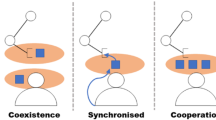Abstract
Multi-robot behavior adaptation mechanism based on cooperative–neutral–competitive fuzzy-Q learning is proposed for coordinating local communication atmospheres in humans-robots interaction, in which the communication atmosphere is represented by a two-layer fuzzy fusion model and is visualized by shape–color–fill–wave graphics. It aims to realize smooth communication between humans and robots in the local and global communication atmosphere coexistent interaction by decreasing the response time of robots and social distance between humans and robots, as well as visualizing the communication atmosphere. Experiments on multi-robot behavior adaptation are performed in a virtual home party environment. Results show that the proposal saves 47 and 103 learning steps (i.e., the learning rate is increased by 72 % and 85 %) compared to fuzzy production rule based friend-Q learning (FPRFQ) and friend-Q learning (FQ), respectively; the distance between human-generated atmosphere and robot-generated atmosphere is 3 times and 7 times shorter than the FPRFQ and the FQ, respectively. Additionally, subjective estimation of graphic visualization of the atmosphere through questionnaire obtains 85.5 % accuracy for shape, 77.2 % for color, 65.3 % for fill, and 91.7 % for wave. The proposed mechanism is being extended to the robot behavior adaptation to international communication atmosphere, where the atmosphere is generated by people from different countries with different cultural backgrounds.














Similar content being viewed by others
References
Murphy RR, Nomura T, Billard A, Burke JL (2010) Human-robot interaction. IEEE Robot Autom Mag 17(2):85–89
Makino T, Aihara K (2006) Multi-agent reinforcement learning algorithm to handle beliefs of other agents’ policies and embedded beliefs. In: Proceedings of the fifth international joint conference on autonomous agents and multiagent systems. Hokkaido, Japan, pp 789–791
Ikemoto S, Amor HB, Minato T, Jung B, Ishiguro H (2012) Physical human-robot interaction: mutual learning and adaptation. IEEE Robot Autom Mag 19(4):24–35
Foster ME, Keizer S, Wang Z, Lemon O (2012) Machine learning of social states and skills for multi-party human-robot interaction. In: Proceedings of the ECAI workshop on machine learing for interactive systems: bridging the gap beteween language, motor control and vision. France, Montpellier, pp 9–11
Brezeal C (2004) Social interactions in HRI: the robot view. IEEE Trans Syst Man Cybern 34(2):181–186
Sargn ME, Yemez Y, Erzin E, Tekalp AM (2008) Analysis of headgesture and prosody patterns for prosody-driven head-gesture animation. IEEE Trans Pattern Anal Mach Intell 30(8):1330–1345
Chutorian EM, Trivedi MM (2009) Head pose estimation in computer vision: a survey. IEEE Trans Pattern Anal Mach Intell 31(4):607–626
Mitsunaga N, Smith C, Kanda T, Ishiguro H, Hagita N (2008) Adapting robot behavior for human-robot interaction. IEEE Trans Robot 24(4):911–916
Isbell C, Shelton CR, Kearns M, Singh S, Stone P (2001) A social reinforcement learning agent. In: Proceedings of the fifth international conference on autonomous agents. Hakodate, Japan, pp 377–384
Tao J, Tan T (2005) Affective computing: a review. Affective Computing and Intelligent Interaction. Spriger, Berlin
Picard RW (2003) Affective computing: challenges. Int J Hum-Comput Stud 59(1–2):55–64
Shi Z, Wei J, Wang Z, Tu J (2012) Affective transfer cpmputing model based on attenuation emotion mechanism. J Multimodal User Interfaces 5(1–2):3–18
Lee KW, Kim HR, Yoon WC, Yoon YS, Kwon DS (2005) Designing a human-robot interaction framework for home service robot. In: IEEE international workshop on robots and human interactive communication. Roman, Italy, pp 286–293
Park S, Moshkina L, Arkin RC (2010) Mood as an affective component for robotic behavior with continuous adaptation via learning momentum. In: IEEE-RAS international conference on humanoid robots. Nashville, USA, pp 340–345
Tews AD, Mataric MJ, Sukhatme GS (2003) Scaling high level interactions between humans and robots. In: Proceedings of AAAI spring symposium on human interaction with autonomous systems in complex environments, Stanford, USA, pp 196–202
Liu Z-T, Wu M, Li D-Y, Chen L-F, Dong F-Y, Yamazaki Y, Hirota K (2013) Concept of fuzzy atmosfield for representing communication atmosphere and its application to humans-robots interaction. J Adv Comput Intell Intell Inform 17(1):3–17
Liu Z-T, Wu M, Li D-Y, Chen L-F, Dong F-Y, Yamazaki Y, Hirota K (2013) Communication atmosphere in humans robots interaction based on concept of fuzzy atmosfield generated by emotional states of humans and robots. J Autom Mob Robot Interll Syst 7(2):52–63
Chen L-F, Liu Z-T, Dong F-Y, Yamazaki Y, Wu M, Hirota K (2013) Adapting multi-robot behavior to communication atmosphere in humans-robots interaction using fuzzy production rule based friend-Q learning. J Adv Comput Intell Intell Inform 17(2):291–301
Eyal E-D, Yishay M (2003) Learning rates for Q-learning. J Mach Learn Res 5:1–25
Filar J, Vrieze K (1997) Competitive Markov decision processes. Springer, Berlin
Littman ML (1994) Markov games as a framework for multiagent reinforcement learning. In: Proceedings of the 11th international conference on machine learning, New Brunswick, USA, pp 157–163
Hu J, Wellman MP (2003) Nash Q-learning for general-sum stochastic games. J Mach Learn Res 4:1039–1069
Littman ML (2001) Friend-or-Foe Q-learning in general-sum games. In: Proceedings of 18th international conference on machine learning. Massachusetts, USA, pp 322–328
Watkins CJH, Dayan P (1992) Q-learning. Mach Learn 8(3–4):279–292
Kaelbling LP, Littman ML, Moore AW (1996) Reinforcement learning: a survey. J Artif Intell Res 4:237–285
Singh S, Jaakkola T, Littman M, Szepesvari C (2000) Convergence results for single-step on-policy reinforcement- learning algorithms. Mach Learn 38(3):287–308
Fong T, Nourbakhs I, Dautenhahn K (2003) A survey of socially interactive robots. Robot Auton Syst 42(3–4):143–166
Karakayali N (2009) Social distance and affective orientations. Sociol Forum 24(3):538–562
Yamazaki Y, Hatakeyama Y, Dong F-Y, Nomoto K, Hirota K (2008) Fuzzy inference based mentality expression for eye robot in affinity pleasure-arousal space. J Adv Comput Intell Intell Inform 12(3):304–313
Mitssunaga N, Miyashita T, Ishiguro H, Kogure K, Hagita N (2006) Robovie-IV: a communication robot interacting with people daily in an office. In: Proceedings of international conference on intelligent robots and system. Beijing, China, pp 5066–5072
Vu HA, Yamazaki Y, Dong F-Y, Hirota K (2011) Emotion recognition based on human gesture and speech information using RT middleware. In: IEEE international conference on fuzzy systems. Taipei, Taiwan, pp 787–791
Tang Y-K, Vu HA et al (2011) Multimodal gesture recognition for mascot robot system based on choquet integral using camera and 3D accelerometers fusion. J Adv Comput Intell Intell Inform 5(5):563–572
Dimoney PF, Warneken F (2011) The basis of shared intentions in human and robot cognition. New Ideas Psychol 29(3):260–274
Yang E, Gu D (2004) Multiagent reinforcement learning for multi-robot systems: a survey. Technical Report CSM-404, Dept. of Computer Science, University of Essex
Kormushev P, Kormushev S, Caldwell DG (2013) Reinforcement learning in robotics: applications and real-world vhallenges. Robotics 2:122–148
Guerrero NN, Weber C, Schroeter P, Wermter S (2012) Real-world reinforcement learning for autonomous humanoid robot docking. Robot Auton Syst 60(11):1400–1407
Hester T, Quinlan M, Stone P (2010) Generalized model learning for reinforcement learning on a humanoid robot. In: IEEE international conference on robotics and automation anchorage, USA, pp 2369–2374
Acknowledgments
The authors wish to thank the reviewers for valuable suggestions that improved the quality of this paper. They also wish to thank Min Ding, Fei Yan, Jiajun Lu, and Maslina Binti Zolkepli for their help with the paper’s revision. This work was supported by the National Natural Science Foundation of China under Grant 61210011.
Author information
Authors and Affiliations
Corresponding author
Rights and permissions
About this article
Cite this article
Chen, LF., Liu, ZT., Wu, M. et al. Multi-robot behavior adaptation to local and global communication atmosphere in humans-robots interaction. J Multimodal User Interfaces 8, 289–303 (2014). https://doi.org/10.1007/s12193-014-0156-1
Received:
Accepted:
Published:
Issue Date:
DOI: https://doi.org/10.1007/s12193-014-0156-1




